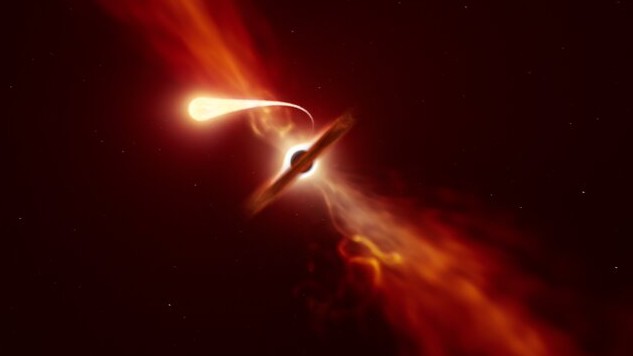Gargantuan black hole 'switches on,' becoming one of the brightest objects ever seen
A black hole 10 billion light-years away suddenly 'switched on', becoming one of the brightest transient objects ever detected.

Scientists scouring the cosmos for signs of a rare explosion may have stumbled upon something even more remarkable: a gargantuan black hole "switching on" in the early universe, going from dim to tremendously bright in a cosmic blink of an eye.
The black hole, dubbed J221951, is estimated to sit about 10 billion light-years from Earth, meaning the cosmic monster turned up its lights when the universe was roughly one-quarter of its current age. Despite this vast distance, the black hole brightened so intensely that astronomers initially mistook it for a stellar explosion less than 1 billion light-years away.
Related: Could Earth be inside a black hole?
The fact that the black hole appeared so bright from so far away makes it one of the single brightest transients — objects that brighten suddenly and then fade — ever detected, according to the authors of a study accepted for publication in the journal Monthly Notices of the Royal Astronomical Society and available as a preprint on arXiv.
"Our understanding of the different things that supermassive black holes can do has greatly expanded in recent years," study co-author Matt Nicholl, an astronomer at Queen's University Belfast, said in a statement. "J221951 is one of the most extreme examples yet of a black hole taking us by surprise."
The first surprise came when the researchers tracked down the path of a gravitational wave, a fast-moving ripple in space-time generated by the most massive cosmic collisions. The team hypothesized that the wave was released during the collision of two dense, dead stars known as neutron stars, which have been known to go out in bright blasts called kilonova explosions.
The ripple in space-time did indeed lead to a bright object. But unlike a kilonova, which first appears blue before dimming to red over several days, this spot in the sky remained bright and blue for months — far longer than a stellar explosion should.
Get the world’s most fascinating discoveries delivered straight to your inbox.
Follow-up observations with multiple telescopes, including NASA's Hubble Space Telescope and Neil Gehrels Swift Observatory, revealed that the mysterious object lines up with the center of a dim and distant galaxy, suggesting that it could be a supermassive black hole, much like the one at the center of the Milky Way. After 10 months of brightening, the object finally began to fade again, proving that it wasn't a galaxy itself but a transient object undergoing an intense, high-energy outburst.
If J221951 is indeed a supermassive black hole, its sudden burst of brightness has two possible explanations, according to the researchers. First, the black hole could have pulled an orbiting star into its clutches, stretching and tearing the star to shreds in a messy process called a tidal disruption event or "spaghettification." The second, more mysterious possibility is that the black hole could have shifted states from dormant to actively feeding, as it suddenly began gorging on the fast-moving disk of gas that surrounds it.
Figuring out precisely why the black hole "switched on" will require further studies of the object's energy output. If the black hole were to suddenly brighten again, it would mean it is probably in feeding mode, the team concluded. But if it fades for good, it's more likely that some unfortunate star was gobbled up in the most spectacular way imaginable. May we all burn out so gloriously.

Brandon is the space / physics editor at Live Science. With more than 20 years of editorial experience, his writing has appeared in The Washington Post, Reader's Digest, CBS.com, the Richard Dawkins Foundation website and other outlets. He holds a bachelor's degree in creative writing from the University of Arizona, with minors in journalism and media arts. His interests include black holes, asteroids and comets, and the search for extraterrestrial life.


